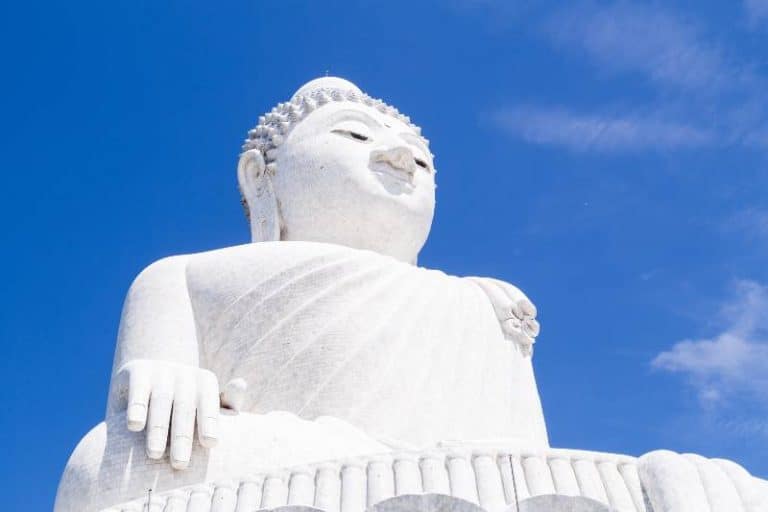Staying Cool in Thailand’s Heat & Humidity (Essential Tips!)
Thailand is known for its lush tropical landscape and beautiful beaches, but the country can also be hot and humid, which can make it difficult to enjoy all that these attractions have to offer. Tourists visiting Thailand should prepare accordingly by learning about the heat and humidity in different regions throughout the year so they can plan ahead and avoid heat-related illnesses or discomfort. In this blog post, we’ll cover everything you need to know – from average temperatures range by month, how humidity affects air quality. Plus tips on how to stay cool when traveling in Thailand during a hot summer day!
Bangkok experiences a wide range of temperatures throughout the year, with December averaging around 20 °C (68 °F) and April soaring to a scorching 38 °C (100 °F). The average temperature and humidity remains high at 82 percent. In the northern regions, winter temperatures can plummet to approximately 10 °C (50 °F) or even lower. These areas receive an average annual rainfall of 1,250 cm.
Key Takeaways
- Adapting to the heat and humidity is essential for anyone living in Thailand. Utilizing local adaptation strategies, choosing the right clothing, and managing dietary habits can significantly enhance the living experience.
- Taking precautions such as staying hydrated, using sunscreen, and avoiding exposure during peak heat hours is crucial to prevent health risks like heatstroke and dehydration associated with Thailand’s tropical climate.
- Embracing local foods, drinks, and traditional methods for staying cool can be highly beneficial in coping with the climate and integrating into the local lifestyle in Thailand.

Understanding Thailand’s Climate
Thailand is tucked away in Southeast Asia and boasts a diverse climate that’s as varied as its enchanting landscapes. This blog post aims to give you an insight into Thailand’s tropical climate and the varied weather conditions across its different regions.
Understanding Tropical Climate
Before we delve into specifics about Thailand’s climate, it’s essential to understand what characterizes a tropical climate. Rainfall and warmth dominate tropical climates, with high temperatures (above 18°C) prevailing year-round, and significant rainfall throughout the year.
Relative to their latitude, tropical climates experience minimal temperature variation. Even though there are slight seasonal variations, for most of the year, you can expect heat and humidity in droves. The length of day and night also remain roughly equal throughout the year, creating a consistent pattern of sunlight.
Thailand’s Tropical Climate
Thailand’s tropical climate is a tapestry of three seasons: the hot season (March to June), the rainy season (July to October), and the cool season (November to February). But don’t let the term “cool season” fool you – while it’s notably milder than the hot season, it’s still generally warm by non-tropical standards.
The hot season can be intense, with temperatures often soaring above 30°C. The heat, combined with high humidity levels, can feel overwhelming, especially for those not accustomed to such conditions. Prepare to sweat!
The rainy season is marked by heavy, albeit short-lived, downpours, typically in the afternoon or evening. Flash flooding can occasionally occur, but it generally doesn’t disrupt daily life.
The cool season brings the most comfortable climate, with less rainfall and slightly cooler but still warm temperatures. This is often the most popular time for tourists to visit.
Weather Variation Across Different Regions
While Thailand is characterized primarily as a tropical climate, there are subtle variations across its regions.
- Northern Thailand: This region experiences the most significant temperature fluctuations, with cooler temperatures at higher altitudes. Winter temperatures in high altitude areas, such as Chiang Mai, can drop to as low as 5°C.
- Northeastern Thailand (Isan): This is commonly the hottest region of Thailand, with temperatures easily exceeding 40°C during the hot season.
- Central and Eastern Thailand: These regions experience less temperature variation but are often subjected to heavier rainfall during the rainy season.
- Southern Thailand: This region is unique as it sits on a narrow peninsula and is influenced by both the Andaman Sea and the Gulf of Thailand. It experiences rainfall more evenly spread throughout the year, and it has two rainy seasons.
The beauty of Thailand’s weather is intertwined with the diversity of its experiences. Wherever you choose to visit, arm yourself with knowledge about the local climate to make the most of your Thai adventure.
Dealing with Heat
Thailand’s tropical climate can present a challenge to those unaccustomed to its heat and humidity. Adequate preparation and smart choices ensure a pleasant and comfortable experience in this beautiful country. In this blog post, we outline ways to deal with the heat, including staying hydrated, wearing the right clothing, and finding shade or staying indoors during peak hours.
Importance of Staying Hydrated
Proper hydration is essential in any climate, but especially so in hot and humid environments like Thailand. As the body sweats to cool down, it loses water and essential electrolytes. Here are some tips to stay hydrated:
- Drink Water Regularly: Keep a reusable water bottle with you and sip water throughout the day. It is recommended to drink at least 2 to 2.5 liters of water daily, but you may need more depending on your activities and how much you are sweating.
- Consume Electrolyte-rich Drinks: Replenish lost electrolytes with sports drinks or even local options like coconut water, which is both hydrating and delicious.
- Limit Alcohol and Caffeine Consumption: Both alcohol and caffeine act as diuretics, potentially leading to dehydration. It is important to consume them in moderation and always make sure to compensate for any potential fluid loss by drinking an adequate amount of water.
Choosing the Right Clothing
The clothing you wear can directly impact your comfort and sweat management while exploring Thailand. Opt for lightweight, breathable materials that wick away moisture and allow for air circulation. Here are some guidelines for choosing the right clothing:
- Fabrics: Natural fabrics like cotton and linen are good choices, while sportswear made of moisture-wicking materials such as polyester or nylon can also help regulate body temperature.
- Colors: Light colors reflect sunlight, helping to keep you cooler, whereas dark colors can absorb heat and make you feel warmer.
- Fit: Loose-fitting clothing allows air circulation and is less likely to stick to your skin, increasing overall comfort.
- Footwear: Consider comfortable, moisture-wicking socks and breathable shoes, especially if you plan to do a lot of walking.
Finding Shade and Staying Indoors During Peak Hours
Part of dealing with the heat in Thailand is knowing when to seek shelter from the sun. The following strategies can help:
- Plan Your Day: Adjust your schedule to avoid being outdoor during the hottest hours of the day (typically between 10 a.m. and 3 p.m.). Explore indoor attractions, take a siesta, or enjoy a leisurely meal during this time.
- Seek Shade: Look for natural or built shade when outdoors, including trees, umbrellas, and awnings. If you’re at the beach, consider renting a beach umbrella or bringing your own portable shade option.
- Sun Protection: Apply broad-spectrum sunscreen (at least SPF 30) to protect your skin, and wear a wide-brimmed hat and sunglasses to further shield yourself from the sun’s rays.
By staying hydrated, choosing suitable clothing, and finding shade or staying indoors during peak hours, you can enjoy the many wonders of Thailand while remaining comfortable and safe in its heat and humidity. In the case that you’re traveling, a cooling neck gaiter provides instant relief from the heat.
Managing Humidity
Thailand’s tropical climate presents unique challenges, including managing high humidity levels both outdoors and indoors. This article aims to guide you on how to navigate Thailand’s humid climate effectively, keeping emphasis on the importance of staying dry, preventing mold and mildew at home, and considering dehumidifiers and air conditioning for comfort and health.
The Importance of Staying Dry
Staying dry in a humid environment like Thailand helps maintain comfort, prevent skin conditions related to dampness, and decrease the risk of heat-related illnesses. Excessive humidity can even hinder your body’s natural cooling mechanism—sweat evaporation—leading to heat exhaustion or stroke. Here are some meaningful ways to stay dry:
- Wicking Clothing: Invest in clothing made from moisture-wicking fabrics, which allow sweat to be drawn away from your skin and evaporate easily. Clothes made from synthetic fibers like polyester or nylon are a reliable choice.
- Foot Care: Keeping feet dry is crucial to prevent fungal infections like athlete’s foot. Sandals can allow your feet to breathe. If you’re wearing closed shoes, consider using moisture-absorbing powders.
- Body Powders: Consider using an anti-chafe or body powder that can absorb excess moisture, preventing rashes and ensuring you stay comfortable.
Preventing Mold and Mildew in Homes
Mold and mildew thrive in humid environments and can cause damage to your property and pose significant health risks. Here are strategies to prevent mold and mildew:
- Proper Ventilation: Ensure your home is adequately ventilated, especially in areas prone to dampness such as the kitchen, bathroom, and laundry room.
- Regular Cleaning: Regular cleaning can inhibit mold growth. Consider using mold-inhibiting products to keep susceptible areas clean.
- Moisture Absorbents: Use moisture absorbent products or desiccants like silica gel packs around the home, particularly in wardrobes and storage areas.
Recommendations for Dehumidifiers and Air Conditioning
Air conditioning and dehumidifiers can be life-savers when dealing with Thailand’s high humidity.
- Dehumidifiers: A dehumidifier serves to reduce the level of humidity in the air. Pick a dehumidifier based on the size of your room and the average humidity level. It’s important to maintain these devices properly, including regular cleaning and ensuring they are put to use in well-sealed spaces for optimum efficiency.
- Air Conditioning: An air conditioner does more than cool the room; it also removes moisture from the air. Regular maintenance, including cleaning and changing filters, can improve their efficiency.
By incorporating these strategies, you can ensure a comfortable living environment even amidst the sweltering heat and humidity that characterizes Thailand’s tropical climate. Remember that the key is to adapt and find what strategies work best for you and your home. This way, you can fully enjoy what Thai life has to offer, without the stickiness!
Health Implications
Thailand’s tropical climate, characterized by high heat and humidity, is a health concern for both residents and visitors especially those from cooler climates. The impact of this climate on health ranges from sunburns to serious conditions like heatstroke. This article will focus on the risks posed by the Thai heat, the importance of sunscreen and protective clothing, and managing dietary habits to cope with the climate.
Risks of Heatstroke and Dehydration
Prolonged exposure to high temperatures, especially when coupled with high humidity, can lead to heat-related illnesses such as heat cramps, heat exhaustion, and the most severe, heatstroke.
Heatstroke occurs when your body overheats either due to prolonged exposure to or physical exertion in high temperatures. The symptoms include high body temperature, altered mental state, alteration in sweating, nausea, and vomiting. It can be a serious condition and requires immediate medical attention.
Dehydration is another common health issue in hot climates. When you’re not taking enough fluids to replace the water lost to sweating, you can become dehydrated. Symptoms of dehydration include dry mouth, fatigue, excessive thirst, and decreased urine output.
To prevent heatstroke and dehydration, remember to:
- Stay hydrated. Drink plenty of water, even if you don’t feel thirsty.
- Take frequent breaks from heat exposure. Choose cooler, shady areas for rest.
- Wear light, breathable clothing.
- Avoid physical activities during the heat’s peak (usually from noon to 3 PM).
Importance of Sunscreen and Protective Clothing
Extended exposure to sun raises another health risk – sunburn. It’s a significant risk factor for skin cancer and signs of early aging. While enjoying the beautiful outdoors of Thailand, it’s crucial to protect your skin using:
- Sunscreen: Use broad-spectrum sunscreen with a sun protection factor (SPF) of 30 or higher. Re-apply every two hours and more often if you’re sweating or swimming.
- Protective clothing: Wear loose, lightweight clothing that covers as much skin as possible. Opt for clothing with ultraviolet protection factor (UPF).
- Sunglasses and hats: Protect your eyes with sunglasses that block out 99-100% of UV radiation. A wide-brimmed hat can protect your face, neck, and shoulders.
Managing Dietary Habits to Cope with the Climate
The food you eat can also affect how you cope with Thailand’s heat and humidity. Here are some tips to manage your diet:
- Stay Hydrated: Apart from water, consume fluids in the form of coconut water, fruit juices, and electrolyte drinks.
- Eat Light: Opt for lighter meals with fruits and veggies that are high in water content.
- Reduce Alcohol and Caffeine: These can lead to dehydration by increasing urine output. Go easy on them, especially during the day.
Overall, living or vacationing in Thailand warrants certain precautions due to its heat and humidity. By staying hydrated, protecting your skin, and maintaining a climate-friendly diet, you can enjoy all that Thailand has to offer while safeguarding your health.
Heat and Humidity in Thailand: Local Adaptation Strategies
When living in or going to visit Thailand, it’s essential to know how local practices have evolved over centuries to cope with the tropical humidity and heat. These strategies incorporate both traditional methods and dietary choices. Understanding and adopting these can help you adapt to Thailand’s intense conditions more efficiently and comfortably.
Traditional Thai Methods for Staying Cool
Thailand’s traditional methods for combating heat are deeply rooted in their culture. Here are some you may consider practicing:
- Dwelling Designs: Traditional Thai homes are built to combat the heat with high ceilings, ventilated walls, and raised platforms. If you’re staying long-term, consider implementing these elements in your home.
- Clothing: The traditional “Pha Khao Ma” is a multi-purpose cloth that can be used as a hat, towel, sunshade, and more. It’s typically made from cotton or a cotton-silk blend that’s breathable and perfect for the humid weather.
- Cooling Baths and Showers: Thais often take multiple cold showers throughout the day to keep their body temperature low and maintain personal hygiene. It’s a simple, quick, and effective method for immediate relief from the heat.
Local Foods and Drinks that Help in Dealing with the Heat
Thai cuisine is known for its distinct flavors and variety. But beyond taste, many Thai foods and drinks have been used for centuries to manage the harsh climate:
- Water-Rich Fruits: Thailand is famous for its tropical fruits such as watermelon, mango, pineapple, and pomelo—all rich in hydration and essential minerals. Consuming these fruits in their original form or as juice can help keep you hydrated throughout the day.
- Coconut Water: Widely available and incredibly refreshing, coconut water is naturally packed with electrolytes, making it an excellent hydration source.
- Spicy Foods: It may sound counterintuitive, but according to Thai wisdom, eating spicy food can trigger your body’s natural cooling mechanism—sweating—which promotes heat loss from your body.
- Herbal Drinks: Many Thai locals drink traditional herbal drinks, known as “Nam Prung,” to cool down. These include chrysanthemum tea, butterfly pea tea, and lemongrass tea, all of which are praised for their heat-dissipating properties.
By incorporating these local strategies into your daily routine, you can navigate the Thai heat and humidity in a way that’s not only efficient but also deeply connected with the country’s rich and enduring traditions.

Heat and Humidity in ThailandFAQs
Is the heat in Thailand dry or humid?
Thailand can be characterized as a tropical and humid country for the majority of the year. The northern region experiences a climate dictated by three distinct seasons, while the southern peninsular area of Thailand has only two.
Is it always hot and humid in Thailand?
Thailand experiences a subtropical climate, resulting in hot temperatures and humid conditions throughout the year. During the peak months, temperatures frequently soar above 40°C (105°F). Even in the relatively cooler “winter” season, daily highs still hover around 30°C (86°F).
Is Thailand high humidity?
Thailand holidays offer a tropical experience with warm and humid weather throughout the year, although there are seasonal variations in the north and south. The climate in Thailand is known for its high temperatures, abundant humidity, and frequent sunny days, except during the monsoon season when most of the rain falls.
What is the climate humidity in Thailand?
Typically, a relative humidity ranging from 40% to 60% is considered pleasant. However, September, with its average humidity of 87%, tends to be the most uncomfortable month. On the contrary, December provides a more bearable experience.
Is Thailand a dry heat?
Thailand is situated between expansive land and water regions, making it prone to the influence of both the summer and winter monsoons. Consequently, the weather in Thailand encompasses six months of rainfall during the wet season, three months of dry and refreshing breezes in the winter, and three months of scorching heat in the summer.
Conclusion
Ultimately, enjoying all the magic Thailand has to offer doesn’t have to be impossible, though it can be challenging. With the right precautions, attitude, and respect for the local climate and lifestyle, you can make your stay in Thailand comfortable and healthy. Remembering a few key tips such as dressing appropriately and managing your dietary habits is essential for conquering the weather.
Drinking plenty of fluids, using sunscreen, and limiting exposure during peak heat hours are important measures for avoiding physical risks associated with this environment. In addition, embracing traditional native methods for staying cool can have a positive impact on integrating into Thai culture.
So take some time to explore the exciting beauty of Thailand while keeping safe! If you’re interested in learning more about living in the tropical climate of Thailand or just need advice on how to adapt – subscribe to our newsletter or reach out to us with any questions you may have!






